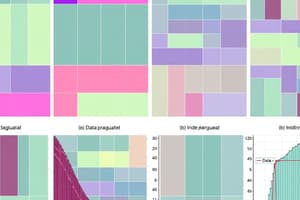Podcast
Questions and Answers
Match each characteristic to the most appropriate data method. Each data method may have more than one characteristic.
Instruction: For each option, select all the answer choices that apply.
Match each characteristic to the most appropriate data method. Each data method may have more than one characteristic.
Instruction: For each option, select all the answer choices that apply.
Reporting = It involves simply presenting the data Reporting = It often requires no human intervention Analysis = It is very flexible and customizable Analysis = It provides answers to questions about the data
Match each analytics category with its description.
Instruction: For each option, select the best answer choice.
Match each analytics category with its description.
Instruction: For each option, select the best answer choice.
Analysis that suggests the best possible way for an organization to operate = Optimization analysis Analysis that looks at what has taken place in the past or is taking place now = Observational analysis Analysis that aims to forecast likely future events based on the data = Predictive analysis Analysis that looks for relationships between data sets and variables = Relational analysis
What are the business intelligence, or BI, classes?
Instruction: Choose all options that best answer the question.
What are the business intelligence, or BI, classes?
Instruction: Choose all options that best answer the question.
- Diagnostic (correct)
- Optimization
- Observational
- Descriptive (correct)
What questions should you ask to help determine which type of analysis fits your business problem?
Instruction: Choose all options that best answer the question.
What questions should you ask to help determine which type of analysis fits your business problem?
Instruction: Choose all options that best answer the question.
What do you need to test in order to ensure the completeness of your analysis?
Instruction: Choose all options that best answer the question.
What do you need to test in order to ensure the completeness of your analysis?
Instruction: Choose all options that best answer the question.
Flashcards are hidden until you start studying
Study Notes
Data Methods and Characteristics
- Data methods can be matched to specific characteristics, with multiple characteristics potentially applying to a method.
- Analytics categories can be matched to specific descriptions.
- Questions to ask can help determine the appropriate analysis for a business problem.
- Testing for completeness involves assessing different aspects of the analysis.
Identifying the Right Analysis
- Questions to consider when determining the appropriate analysis include what is the purpose of the analysis?
- Additional questions to ask are: What type of data is available?
- Further questions involve: What is the desired outcome? Are there any constraints or limitations?
Analysis Completeness
- Components to test for completeness include: data accuracy, data completeness, and appropriate analysis technique.
- Ensure that the analysis addresses the business problem and provides actionable insights.
Studying That Suits You
Use AI to generate personalized quizzes and flashcards to suit your learning preferences.


